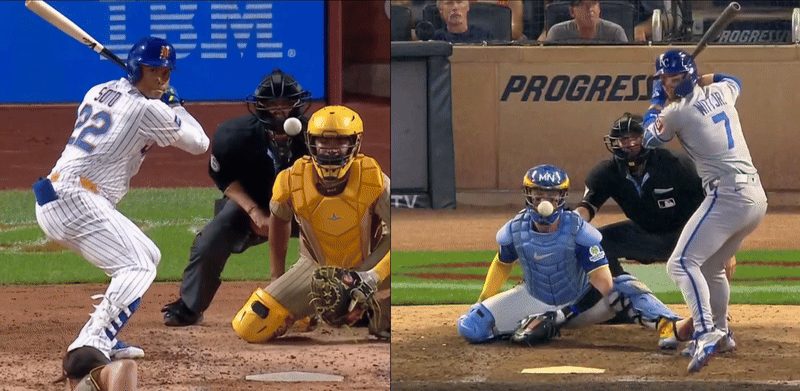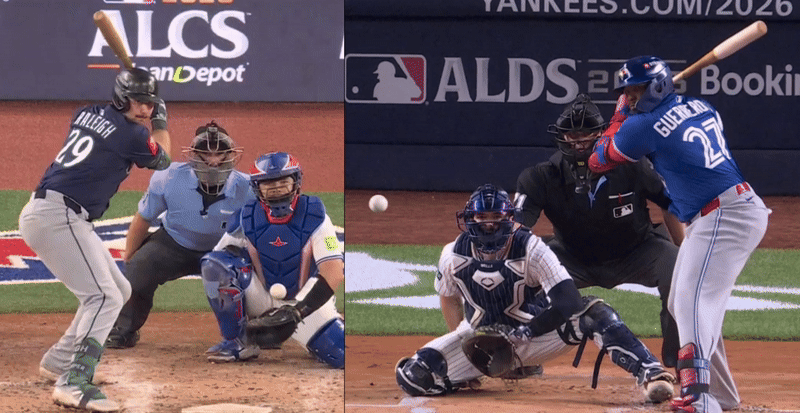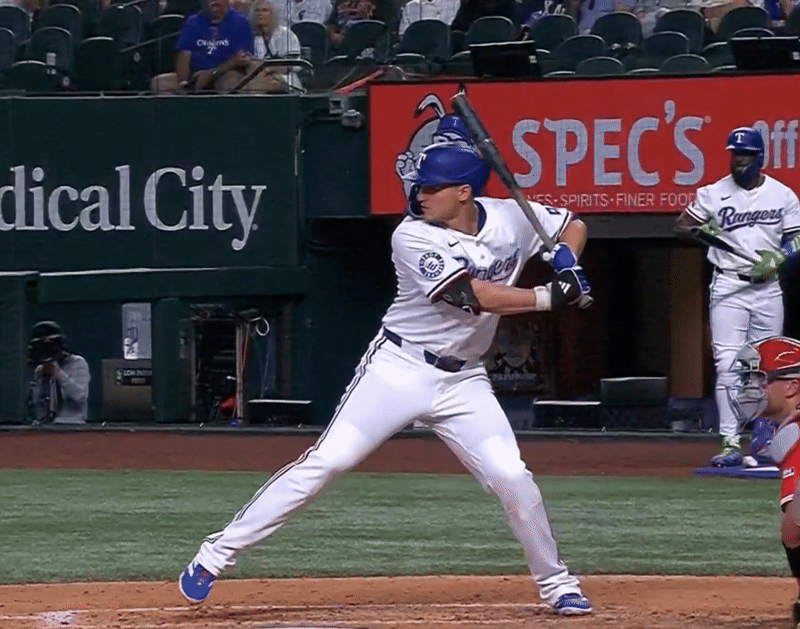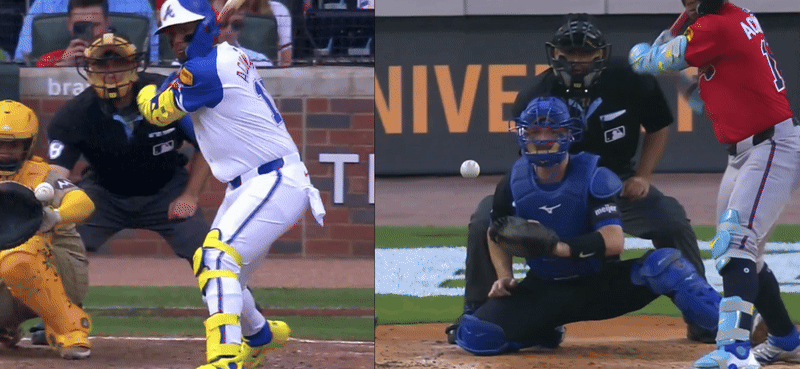
How guys rotate is the most complicated, but most important part of the puzzle. Of all the style involved in the swing, rotation is the one thing that unites us all. It doesn’t have to look a certain way, but certain things do need to happen. Great hitters are great rotational athletes. If movement has become a barrier to performance, you can ultimately trace it back to some subset of bad rotation: Something either isn’t turning when it should, or it’s turning when it shouldn’t.
To ease some of the complexity involved, I’m going to break this phase into two interdependent buckets:
- What’s the body doing?
- What’s the barrel doing?
Starting with the body, below are some things I would consider when evaluating how a hitter rotates:
- How much does the body rotate? Is there a lot of pelvic/chest rotation, or does the swing require less? Does the chest close gaps of separation into contact?
- Is there more of an external rotation bias or internal rotation bias? Hip flexion or hip extension?
- Does the hitter utilize a kick back move? If so, when?
- Does the hitter rotate with more forward trunk flexion, or less? Do they create a lot of side bend, or less?
- Are the hips able to decelerate post contact?
- Is there any sort of shifting, spinning, or wobbling/caving at the front leg?
- Does the hitter maintain space between their feet while rotating? Does the back foot find the ground again post contact, or does it get dragged forward into hip flexion?
- Do the head and spine stabilize and maintain alignment while the body rotates?
There’s a lot of detail in this part, but I like to make it as simple as this: It’s either good rotation, or bad rotation. “Good” is less about aesthetics and more about function. Function comes down to an alignment between strategy and capacity: If how the athlete is choosing to rotate reflects how their body should physically move, it’s functional. If something doesn’t rotate the way that it should, whether it’s a poor strategy or lacking capacity, it’s not functional. Sometimes you have to create better front side mechanics. Other times you need to put the front side in a better spot to move.
To figure out whether alignment exists, I like to see where guys exist on a few different spectrums:
- Degrees of overall rotation
- Internal vs. external rotation bias
- Hip flexion vs. extension bias
- Amount of trunk flexion and side bend
Having a pulse for where guys are at here adds some color to the picture. Everybody has specific strategies they tap into when they want to rotate fast. Some of these strategies are more innate – retroverted hip sockets will always favor more external rotation. Others are learned – finding tension in the toes after years of practicing with a quad dominant back leg. I think the important piece here is finding what’s likely not going to change with coaching. Some strategies they’ve picked up over the years might need rewiring. But plenty of others exist to give you a structure to work within.

Witt: More hip extension, external rotation, & less degrees of overall rotation
From a software standpoint, good rotation can look very different based on how guys present. But if I’m looking for “bad” rotation, I’d start with the following three things:
- Are the hips able to rotate cleanly into contact without any barriers to action?
Hip rotation is the foundation for rotation of the body. Where the hips go, the chest will follow. Any sort of shifting (body leaks forward), vaulting (hips extend early), or an insufficient amount of rotation (premature deceleration) will impact the delivery of the barrel. Under-delivered hips create under-delivered barrels.
- Are the hips able to decelerate post contact?
How the body decelerates plays a big role in the transfer of energy up the chain. Just the way you’d crack a whip, the hips have to create a stopping moment to accelerate the upper body through. If you watch how the hips rotate into contact in slow motion, you should see the belt buckle freeze in space for a moment after contact. This is the hand stopping to crack the whip. If this never happens, the front hip will spin and continue to rotate to the pull side. The upper body doesn’t have anything to rotate against, negatively impacting both direction and force transmission.
- Do the head and spine stabilize and maintain alignment during trunk rotation?
Most of the discussion to this point has been around the hips, but how the trunk moves has a big influence on the barrel. The spine is the axis of rotation for the body. The hips and chest have to rotate around the spine to create space for the barrel to work. Any sort of shifting forward, leaning, or loss of posture (trunk loses flexion while rotating) changes the body’s axis of rotation. When the center point for the body moves, how the barrel moves around the body ultimately changes. It’s tough to ask the barrel to get to similar end points when it has to change its course mid flight.
…
Moving to the barrel, below are some things I would consider when evaluating bat path:
- Does the barrel get delivered consistently? When it does, what does ball flight look like?
- What’s the general shape of the path? Flatter? More vertical?
- Do the hands push, or does the barrel turn and create depth behind the ball?
- Does the barrel turn with the torso? Or does it drag behind during trunk rotation?
- Where is the overall point of contact? Is the barrel traveling up or down into contact?
- Does the back hand work with the back elbow?
- Does the lead shoulder work up as the back shoulder works down?
- What kind of length is created post contact? Is the bat out of the zone early, or does it stay through the zone?
- Is it more of a two plane swing with a vertical to horizontal entry (e.g. barrel tip), or does the bat work on more of a horizontal plane with the torso (e.g. flatter barrel set up/entry)?

Of all the things you can evaluate here, the first question is ultimately the most important question: Does the barrel get delivered consistently?
“Delivered” is synonymous with any of the following – closed (from golf), flush, square. For the purpose of the explanation, I’m going to use the term “square.” When delivering a strike – baseball, golf, tennis, etc. – the part of the implement you’re using to strike the ball needs to get square to its intended target. If your goal as a hitter is to hit the ball to center field, the bat head needs to face center field at contact. If the barrel is angled towards right field in this situation, it would be considered late, open, or not delivered. This could create a swing and miss, foul ball, or clip/slice.
Using the same situation, let’s say the hitter got the barrel square to center field at contact. The initial trajectory of the ball heads towards center field. But as the ball ascends, it changes trajectory and starts to slice towards right field. This isn’t an issue with getting the barrel delivered. It’s a path problem: How the bat is moving negatively impacts ball flight off the bat.
These two observations create a simple, but effective framework when navigating path issues. If general contact or direction are off, the barrel needs to get square. If the flight and trajectory are off, the barrel needs to move differently.
If the barrel isn’t getting square, below are some potential reasons why:
- Poor hip rotation
The hips play an integral role in producing contact to different parts of the field. If you want to pull the ball, you need a point of contact a little further out in front. This requires more hip rotation. If you want to work to the opposite field, the point of contact shifts further back towards the catcher. This requires less hip rotation. If the hips stop rotating prior to contact, the body ends up decelerating at a critical moment in the swing when it should still be accelerating. The barrel isn’t to blame in this case. The body left it out to dry.
- Bad swing thought
It’s one thing to think about staying inside the ball. It’s another when the thought of staying inside the ball causes the barrel to never get delivered. You can do whatever you want to change the swing from a drill standpoint. If the swing thought never gets reframed into something more productive, the same issues will continue to show up. You have to change the thought process behind the movement first. The same bad blueprint will create the same bad movements. You can only begin to introduce a better movement if you take the time on the front end to build a better blueprint.
- Too much counter rotation
The further your body turns prior to the swing, the more work your barrel has to do to get back to center. Instead of starting at the start line, the barrel ends up starting twenty yards behind the pack. Can it overcome the bad starting position? Potentially. But it’s a lot easier if you just eliminated the clutter on the back end and had the barrel work from a better position to start. Everyone is going to create some sort of movement in the transverse plane during the load. The barrel will tell you when it’s become too much.
- Shifting
When the body rotates, the front side has to stop, stabilize, and prevent the body from shifting forward. This stopping moment helps decelerate the hips and slingshot the upper body/barrel through. If the body never stops shifting forward, the barrel can’t get across the body. It gets caught dragging behind because the axis it needs to rotate around keeps shifting forward. It looks like the barrel is late, but it’s not the barrel’s fault. The body never gives it a chance.
- Dragging
When the body starts to rotate, the barrel has to be ready to go. The two turn in tandem. There are points in the swing where one thing needs to move before the other (hip to shoulder separation). This is one of those moments where you can’t afford a delay in the action. Rotation of the chest should initiate rotation of the barrel. If it doesn’t, the barrel ends up wasting precious time dragging behind the body.

If the barrel is getting square but the ball isn’t doing what you want it to, below are some questions I would ask to address overall path:
- What pitch locations/parts of the field are easiest to utilize? Most difficult?
- Does the barrel push and do the hands take over, or does it turn and unwind around the shoulders?
- Is there a positive ascension into contact? Does the barrel remain on a positive ascension post contact?
- Does the barrel work inside to out, or outside to in? Where is the majority of the length in the swing created?
The first question is designed to gather context. It’s not a path problem until there’s something you need to do that you don’t have the ability to (more on this in the next part). The next three questions address the overall shape of the path. Below are three different buckets you can group a large majority of those problems into:
- Push: Any movement where the hands push and get ahead of the body instead of rotating with the torso. Some of it can be thought influenced (e.g. take your hands straight to the ball). Other times it’s tied to someone’s identity as a hitter (e.g. the put the ball in play/contact guy who doesn’t miss). Misses are going to be on ground or high spin pop ups.
- Dump: Excessive barrel depth behind the torso during trunk rotation. Misses will be under/late.
- Cast: When the hands push away from the body during rotation of the chest. These guys will be your out-to-in paths. They’ll hit a lot of stuff to the pull side, but struggle to stay inside something and keep it off the ground.
Diving further into ball flight, you can reverse engineer from certain outcomes to get a lot of information on how the body and barrel are working together. This is a huge part in figuring out if how someone is rotating is functional or not. Every batted ball tells a story. Your ability – or inability – to hit a ball at a specific angle, direction, and velocity tells a lot about how you moved to get there. This is helpful for both evaluation and training. If we know the game is going to demand specific things, the swings we build have to be able to hold up against those demands. How we hit is largely dictated by what we have to hit.
Looking at this from a macro lens, below are three different outcomes I’d want a hitter to be able to execute on:
- Can you hit a low line drive to center field?
- Can you work to the opposite gap with power?
- Can you pull something in the air and stay behind it?
The outcomes here are likely to be important in a game setting at some point. But I’m more interested in how the body moves to achieve these outcomes. For example, hitting a low line drive is going to challenge your ability to flatten out the barrel. Your ability to do this can come from a lot of places – trunk/hip flexion, vertical bat angle (VBA), depth of barrel at entry. An inability to work on a line can also come from a lot of places. It might be a path issue – dragging, dumping, loss of connection during rotation. It might be a front side issue. Low flight becomes a lot tougher to achieve when the front side spins and the torso reverses posture.
Working to the opposite gap is going to challenge the general sequencing of your lower body. You have to be able to decelerate the hips, rotate from posture, and work against the front side to create some direction to the opposite field. Keeping the focus on driving a ball to this gap ensures path integrity remains in tact. You can throw your hands and poke something into the oppo gap. You have to connect the turn up top if you want to work there with some power.
Pulling something in the air is going to demand more pelvic rotation to create a further point of contact. This increase in pelvic rotation also has to be coupled with adequate hip flexion, torso mechanics (getting across the body), and a stable axis of rotation. And sort of shifting, spinning, or inefficiencies with posture will either delay the barrel or impact the arc on which it has to travel. The general path shape will be a little more vertical. If the barrel drags, it won’t get delivered. If the shape is out-to-in, the ball won’t get off the ground.

While there are many more layers to how the body moves in these situations, the big takeaway is this: Everyone is going to bias a little differently. These batted ball outcomes require very different moves. Specific moves might fit like a glove for certain players. Flatter VBA and less pelvic rotation are going to crush low flight, opposite field rounds. Other moves are going to take some learning/hedging – teaching those same hitters to pure a ball in the air to the pull side. The key is making sure the strengths stay the strengths. The weaknesses will get addressed with some time, attention, and consistent work. But if the hitter who pulls the ball with ease gets too hyper focused on working to the opposite field, they’re going to lose the one thing they do really well: Pulling the ball.
“We know the game is going to demand specific solutions in a variety of areas. It’s irresponsible if we don’t give guys exposure to all of these areas in some capacity. But it’s equally irresponsible if we sacrifice the thing they’re really good at for something they’re not.”
We know the game is going to demand specific solutions in a variety of areas. It’s irresponsible if we don’t give guys exposure to all of these areas in some capacity. But it’s equally irresponsible if we sacrifice the thing they’re really good at for something they’re not. We don’t need to be great at everything. But we do need to be great at something.
For my final point: This section has detailed out the process of how someone rotates. You’re going to find problems in this phase of the swing that likely didn’t originate in this phase of the swing. Bad initial moves that shoot guys into too much counter rotation will suck up precious time for the barrel to get square. These might look like issues with how the body rotates – partially because they kind of are. But they didn’t start in this phase of the swing. They happened before the body had a chance to make a move to the ball. Solve these problems where they happened. The solutions exist upstream. The problems only become more obvious downstream.
The roots of most of the issues you see are going to occur at two points in time: 1) Before rotation, or 2) During rotation. If barriers to rotation exist before the body has the chance to, address those problems upstream (see part I and part II of this series). If how the body is actually rotating is the problem, center your focus there. Everyone likely has some low hanging fruit in regard to how the body rotates. But the big thing you want to avoid is banging your head against the wall trying to solve a problem that started somewhere further up the chain. Just the way not all movements should receive the same amount of weight, problems should be treated as such. Start with the ones that will get you the best return on your work.
Let your work evolve from there – because it will. And if you have a foundation in mind for what you want, what it’s going to look like, and what it’s going to create, you’re going to get where you want to a lot faster. First principles thinking isn’t just going to get us to Mars.
It’s going to help us to build better hitters a lot quicker.
*All images & video/gifs from MLB film room
